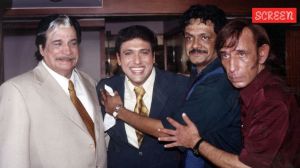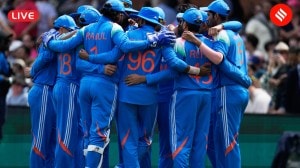‘Kuch khaas hai hum sabhi mein,’ was his very essence: Ad world remembers legend Piyush Pandey
From Rahul da Cunha, the man behind the Amul campaign, to Hephzibah Pathak, executive chairperson, Ogilvy India, to veteran ad professional K V Sridhar, fondly known as ‘Pops’, prominent figures in the advertising industry recall their association with Piyush Pandey, who passed away on Friday.
 Pandey, a Padma Shri and LIA Legend awardee, passed away on Friday morning at 70 after an infection turned critical.
Pandey, a Padma Shri and LIA Legend awardee, passed away on Friday morning at 70 after an infection turned critical.
For over four decades, Piyush Pandey told India’s stories — with warmth, wit, and a language that felt like home. His ads didn’t just sell products; they reflected who we were. From the girl dancing on a cricket field in Cadbury Dairy Milk’s “Kuch Khaas Hai” to the crowded bus in Fevicol’s “Fevicol ka Jod” and the emotional reunion in Google’s “Reunion”, each carried his unmistakable touch.
Pandey, a Padma Shri and LIA Legend awardee, passed away on Friday morning at 70 after an infection turned critical.
A former Ranji cricketer from Jaipur, Pandey joined Ogilvy in 1982 and went on to redefine Indian advertising — replacing polished English with colloquial Hindi and emotion. His campaigns for Asian Paints, Vodafone, Ponds, and ‘Do Boond Zindagi Ki’ became cultural milestones. Beyond ads, his ‘Mile Sur Mera Tumhara’ remains an enduring anthem of unity and pride.
To his peers, Pandey was not merely an adman — he was the storyteller who made brands speak in India’s own voice, and in doing so, made India listen to itself.
Poster boy of advertising
“We aren’t able to get over it,” said Rahul da Cunha, theatre writer-director and the man behind the Amul campaign. “He was ailing and in the ICU for a month — we knew, but we weren’t ready.”
“He was the poster boy of advertising. Often, the poster boy of a business doesn’t represent everyone’s idea of it — but he really did. He changed the way clients thought, the way consumers thought. He created a space for ad professionals that others could follow. He gave the business a grammar. All the cliches — giant, legend — are valid for this man,” said Da Cunha, adding that his favourite campaign remains Fevicol’s.
“To me, great advertising isn’t about a great line. ‘Har Ghar Kuch Kehta Hai’ is a great line, yes, but the way he used the benefit of ‘sticking together’ so brilliantly in the Fevicol campaign stood out. You never even see the product in use. His storytelling was pure genius,” he pointed out.
Da Cunha added, “I wouldn’t say he defined advertising. That would be unfair to the giants before him and those after, but he Indianised it. He brought heartland thinking into the mainstream. He respected the Indian consumer and the Indian client, which is most important. With ‘Har Ghar Kuch Kehta Hai’, he took Asian Paints beyond paint, because he was talking about home.”
“The most important thing,” Da Cunha said, “was that clients respected him. And when a client respects you, it means you truly understand the brand, and that’s what Piyush did.”
“It’s hard to capture the immense impact Piyush had on all of us. He didn’t just change the game for our industry; he changed our lives. A giant of a leader, his fearless heart and unwavering goodness inspired us to see the world, and ourselves, differently. His beautiful philosophy, ‘Kuch khaas hai hum sabhi mein,’ was his very essence, always finding and celebrating the specialness in everyone. We were so privileged to have been nurtured by him. Godspeed, Piyush. Rest in eternal peace,” said Hephzibah Pathak, Executive Chairperson, Ogilvy India, to The Indian Express.
Veteran advertisement professional K V Sridhar, fondly known as ‘Pops’, said he and Pandey knew each other for over 40 years. “What separated Piyush from others was that he borrowed ideas from life. He could take a complex marketing problem, break it down to something simple, and connect it to a memory or observation. That’s what made his work so powerful,” said Sridhar, CCO at Nihilent and founder of HyperCollective.
His favourite Pandey campaign was for SBI Life Insurance, where an elderly man buys a diamond ring for his wife on Valentine’s Day. When she says, ‘Ab is umar mein kahan pehnugi heera?’ the husband replies, ‘Arey, heere ko kya pata tumhari umar.’
“It was so inspiring and beautiful that my father, who had never bought my mother a diamond, did so after seeing that ad. I called Piyush immediately to tell him,” Sridhar recalled.
‘He was proud of who he was and wore it like a medal’
“He represents an inflection point,” said Kiran Khalap, Co-founder and MD at ‘chlorophyll’, a leading branding agency. “While you see the debate between India and Bharat happening today, it was actually in the mid-80s when that distinction was first made,” Khalap said.
“I joined advertising in 1982, and at that point, the dominant medium was newspapers. All of us so-called copywriters lived in this echo chamber of English. We were more concerned about impressing other agencies than reaching the end consumer. That was the prevailing milieu,” he said, adding that with the 1982 Asian Games came television, and with it, the local language.
“Piyush disentangled Indian advertising from the clutches of the English language. He told stories that the common person could relate to like ‘Chal Meri Luna’ campaign that saw a young, independent woman whose life changes because of a moped. That was the inflection point — the shift from Shakespearean English to visual, idea-driven storytelling that transcended language,” Khalap said.
He also recalled Pandey’s campaign for Rajasthan Tourism, which he described as “beautiful and impactful enough to make tourism skyrocket in the state.”
Earlier in the day, former Rajasthan Chief Minister Vasundhara Raje shared a video of the state’s first-ever ad campaign, ‘Jaane Kya Dikh Jaaye’. “With his ability to craft impactful, rooted, and layered stories, he gave us masterpieces that redefined the advertising landscape in India,” she said, adding, “His beautiful reimagining of our vibrant and magnificent Rajasthan stands as a timeless ode to this fabled land.”
Lyricist, writer, poet, and advertising professional Prasoon Joshi shared how, when he came to Mumbai, there was a misconception among people like Pandey and him — those from smaller towns — that the language they spoke at home didn’t belong in agency corridors.
“Piyush changed that. He told everyone to use their own language, to blur the line between who you are and what you create. That’s what I learnt from him — that ideas don’t come from pretending, they come from honesty. From who you are, from what you’ve lived,” said Joshi.
He recalled an incident that showcased Pandey’s pride in his roots. “Once at Cannes, we were sitting in one of those buses going to the venue. Out of nowhere, he started humming a Rajasthani folk song. Then, one by one, he made the entire bus — full of people from different nationalities — join in. He was proud of who he was and wore it like a medal. He never pretended.”
Agrees Rajesh Chaturvedi, co-founder and chairman of Adfactors PR. “He revolutionised Indian advertising by infusing diverse Indian voices, dialects, humour, and emotion. If you look at his campaigns, including ‘Fevicol Ka Majboot Jod’, he connected products with local sentiment. He knew exactly who his audience was and how to communicate with them. That’s the mark of a great communicator.”
He belonged to everyone
Pandey joined Ogilvy in 1982 and remained there throughout his career. But for many in the profession, he belonged to everyone.
“It was my first Cannes Gold (for Sindoor Khela campaign), and he had just received the Lion of St. Mark, the lifetime achievement award at the Cannes Advertising Festival in 2018. He had the biggest honour in his hands, but he was so proud of me. He kept patting my head and saying, ‘Shabash, shabash… bohot badiya,’” recalled Swati Bhattacharya, Global Head of Godrej Creative Lab and former Chief Creative Officer at FCB Ulka Advertising.
“Piyush didn’t just belong to Ogilvy — he was ours too. He was the one we all wanted to impress, the one whose pat on the head made us taller, stronger, sharper. Everything he wrote was something we memorised like a Beatles song,” she said.
Sharing one of his key lessons, she added, “He was the first to tell us that the emotional quotient of brands mattered as much as the emotional quotient of humans.”
Gaurav Gupta, a freelance advertising director and former Ogilvy employee, recalled his first meeting with Pandey at Ogilvy’s Mumbai office in 2015, during the launch of his book, Pandeymonium: Piyush Pandey on Advertising.
“He was someone we all looked up to, someone who shaped the way we think, write, and create. Most of us in advertising were inspired by him to join this industry — to dream big and stay true to our craft. His campaigns, his jingles — from Air India to Asian Paints and Fevicol — have left an unforgettable mark on Indian advertising,” Gupta said.







